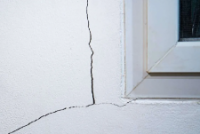For someone who's never heard of it before, what exactly is subsidence?
Subsidence is the gradual sinking or downward settling of the ground's surface with little or no horizontal motion. It can cause buildings to move with the ground, potentially leading to structural damage.
Factors that can contribute to subsidence include the natural compaction of soil over time, the removal of underground water, the decay of organic materials in the soil, or the collapse of old mines. Shrinking and swelling of the ground brought about by drought followed by prolonged wet conditions are also thought to increase the risk of subsidence.
It is a growing threat for property owners around the country, risking structural integrity and financial security.
In fact, the British Geological Survey published a report in 2021 projecting that up to 57 percent of properties in London could be affected by 2070. That's a massive increase.
Can you tell us about the inception of Subsidence Ltd. and what drove you to focus on subsidence repair?
The journey began with a clear mission. Having seen just how disruptive and expensive traditional methods of repair were, we knew there had to be a better solution.
We wanted to offer a faster, less intrusive, and more environmentally friendly solution to subsidence. That's where our innovative resin injection technology comes into play
What makes your resin injection method stand out from traditional underpinning?
Our technique of subsidence repair is designed to be minimally invasive. It is a rapid and effective solution that doesn't require the extensive excavation required by traditional methods.
This approach not only saves time but significantly reduces the environmental impact.
With the UK's varied geology, how do you tailor your approach to meet the customer's needs?
Our country's geology presents unique challenges, especially in the south east and London in particular where instances of subsidence are forecast to increase substantially in the coming years.
We conduct thorough site assessments to customise our strategy, ensuring a tailored and effective repair for each property.
What areas do you cover?
We cover the whole of the country. If you have a townhouse in London or a farmhouse in Cheshire, we can send a team out to identify the problem and get it fixed.
How does your company prioritise sustainability?
Sustainability is at the core of our operations. From using eco-friendly resin instead of underpinning to not having to carry out excavations, we're committed to minimising disruption to the surrounding area whilst promoting greener solutions within the industry as a whole.
What trends or innovations do you anticipate in subsidence repair?
The introduction of resin injection was a big change for the industry, but I think there's much more to come.
There will be more integration of technology over time. For example, I could foresee a situation developing where AI could be used to flag problem areas based on geological and meteorological data analysis for early detection. Paired with periodic satellite imaging, this could help monitor conditions over a large area. And developments in autonomous robotic technology could also help identify and classify cracks in drainage systems, more reliably distinguishing cracks caused by subsidence from those that aren't.
What advice would you offer to entrepreneurs aiming to innovate within traditional industries like yours?
My advice is to stay curious, be persistent, and always look for ways to improve.
Challenges are opportunities in disguise. Focus on sustainability and how your innovation can solve real-world problems.
Visit Subsidence Ltd for more information.






